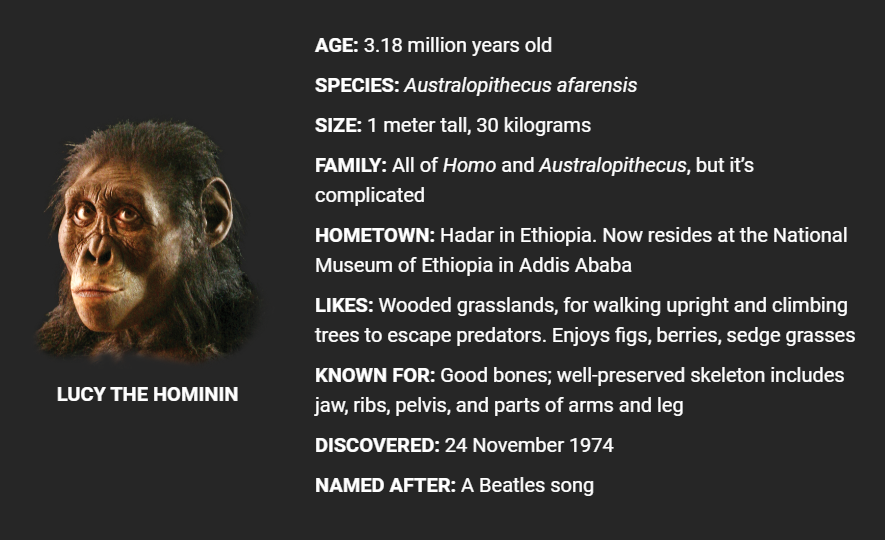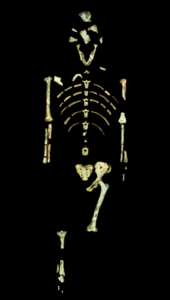Lucy’s World

Zeresenay Alemseged doesn’t remember the 1974 discovery of the famous fossil Lucy at Hadar in Ethiopia, because he was 5 years old, living 600 kilometers away in Axum. Later he saw Lucy’s name on cafes and taxis, but he knew little about her until he became a geologist working at the National Museum of Ethiopia. Then, she changed his life. In 2000, Alemseged was swept into Lucy’s orbit: He discovered “Lucy’s child,” a partial skeleton of a toddler of her species, at Dikika, 10 kilometers from Hadar. In 2015, by then a well-known scientist, he had the honor of showing Lucy to then-President Barack Obama before a state dinner at Ethiopia’s National Palace. Alemseged allowed Obama to touch the prized skeleton, telling him the fossil shows Ethiopia is the birthplace of humankind and that “every single person” on the planet shares an origin in Africa. “Including Donald Trump,” Alemseged joked to Obama.
Fifty years after her discovery, “Lucy is an icon,” says Alemseged, now a paleoanthropologist at the University of Chicago.
Indeed, the 3.18-million-year-old has reigned as the matriarch of the human family ever since she was announced as the earliest known ancestor of our genus, Homo, as well as of all other hominins that came after her. Heads of state paid court to her. Scores of Texans lined up to see her in 2006 when she made a U.S. tour, which was controversial because many scientists thought she was too fragile to travel. Even Ivanka Trump got an audience. But like many aging monarchs, Lucy now faces a new world, rife with competition for attention and status from her extended family.
Five decades of research have brought Lucy to life, showing how she walked upright even though she still had a small brain and apelike upper body, which probably allowed her to climb trees to feed, nest, or escape predators. More than 400 newer fossils of males and females, as well as the Dikika child, have revealed how her species, Australopithecus afarensis, grew, socialized, and evolved during its million-year span on the planet, from perhaps 3.85 million to 2.95 million years ago.

Lucy’s iconic partial skeleton, 40% complete, was discovered at Hadar in Ethiopia in 1974.BRUCE FRUMKER
But researchers’ view of Lucy’s world and her place in it has changed. She is no longer the earliest known member of the human family. Members of her species didn’t take their first upright steps in open savanna grasslands, as her discoverers thought, but walked first in a grassy woodland with deciduous trees. She and her kind weathered climate change, adapting to different habitats over the millennia. Most important, she wasn’t alone in the landscape. “We have multiple [hominin] species in the same time period,” says Yohannes Haile-Selassie, director of the Institute of Human Origins (IHO) at Arizona State University, who is co-organizing a symposium this week on Lucy’s impact on human origins research.
Haile-Selassie and some others think that 3 million to 4 million years ago, the human family tree was more like a bush than a bonsai, with multiple stems growing side by side rather than a single trunk. He and others now see Lucy as more of a great-great-great-aunt than a direct human ancestor. But Alemseged and others point out that so far, no other fossil is a better candidate for being the mother of us all.
Even as paleoanthropologists debate her place in the human family tree, they agree no known human ancestor has had the impact of Lucy. They still marvel at the detailed view of our past revealed by her skeleton. Forty percent complete, it has served as a template for fitting together the isolated bones of dozens of other members of her species, like pieces in an incomplete puzzle. “More people have come to look and analyze Lucy’s skeleton than any other fossil in the world,” says IHO paleoanthropologist Kaye Reed.
Back in 1974, researchers didn’t realize just how rare such a well-preserved hominin skeleton would turn out to be. “Fate played a miserable trick—it gave us the best fossil early on,” says paleoanthropologist Bernard Wood of George Washington University. “It’s as if it’s my birthday and I’ve opened my first present and it’s exactly what I want … so you think that all the other presents will be as good as this one.”
THAT FOSSIL GIFT of a lifetime was first unwrapped by Don Johanson. Then a young American paleoanthropologist at the Cleveland Museum of Natural History, he had joined an expedition at Hadar organized by late French geologist Maurice Taieb. On 24 November 1974, halfway through the second field season, Johanson and student Tom Gray were walking back to their Land Rover after a discouraging morning when they had found little of interest. Then, Johanson saw a bit of Lucy’s arm bone on a hill in a dry gully. Next he spotted a skull piece, a thighbone, part of a pelvis, and vertebrae: a rare partial skeleton.
The team celebrated the discovery in camp, drinking beer and blasting the Beatles’s song Lucy in the Sky with Diamonds all night. Someone started to call the skeleton Lucy, and the name stuck.
“The real importance of Lucy is we didn’t know what an early human ancestor looked like,” says Johanson, founder of IHO. He recalls that he was immediately impressed by how small and primitive Lucy was compared with known members of Australopithecus, such as A. africanus, a hominin found in South Africa almost a century ago, and thought at the time of Lucy’s discovery to be about 2 million years old. “I was struck by her more apelike features,” he says.
Lucy was the first hominin to break the 3-million-year time barrier, pushing back the age of the human family to a time closer to when geneticists thought the ancestor of humans had split from the ancestor of chimpanzees. Lucy “entered a field actively debating the antiquity of the chimp/human split,” says Tim White, a paleoanthropologist at the University of California, Berkeley who coauthored the landmark 1978 paper describing Lucy’s species with Johanson and the late paleoanthropologist Yves Coppens.
For the first 20 years after Lucy’s discovery, her species was the oldest known member of the human family. A. afarensis was “the only game in town” between 3 million and 4 million years ago, says Carol Ward, a paleoanthropologist at the University of Missouri. Many researchers concluded that her species gave rise to all the hominins that came later, including Homo, A. africanus, and more robust members of the human family such Paranthropus aethiopicus, P. robustus, and P. boisei.
“Once upon a time, life was relatively simple because anything before 3 million years was A. afarensis … [and] it was the mother of us all,” says paleontologist Fred Spoor of the Natural History Museum in London. “That was the gospel.”


